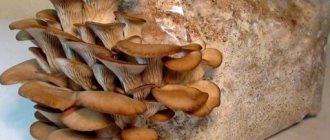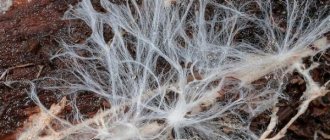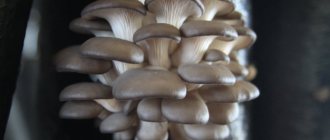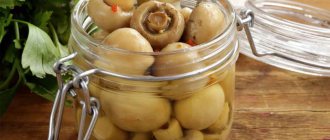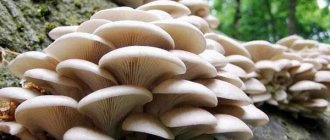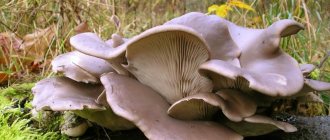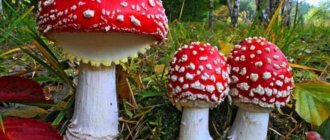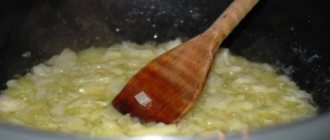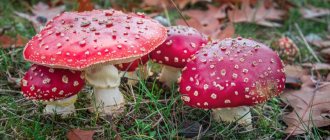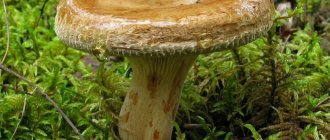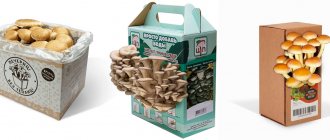Mushrooms
0
1443
Article rating
Kira Stoletova
Oyster mushroom, or oyster mushroom, is a type of edible mushroom that grows in forests of the temperate climate zone. Growing oyster mushrooms in an apartment has several features. By adhering to established care rules, you can enjoy the refined taste of this delicacy all year round.
Growing oyster mushrooms in an apartment
Types of growing oyster mushrooms
You can grow oyster mushrooms in an apartment in the following ways:
- Growing in natural conditions: this is the minimum cost (one might say “budget”) option. You just need to choose a suitable substrate and provide watering. The disadvantages of this method include a long wait for the fruiting bodies to ripen and low yield.
- Growing under artificial conditions: this is a much more labor-intensive and financially expensive method. It is necessary to equip a special room with controlled lighting, temperature and humidity.
After choosing the breeding method, they decide on the place where they install the necessary equipment and purchase the mycelium.
How to grow homemade mushrooms.
Honey mushrooms are suitable for growing on a windowsill. Chanterelles and boletus will only be able to grow if a favorable microclimate can be created. Avoid exposure of the mycelium to sunlight. On glazed balconies it should be possible to regulate the temperature and it is necessary to ensure air circulation in the room. In this case, it will be possible to create the conditions for the mushrooms that they need.
Attention!
- Before growing oyster mushrooms, you should take an allergy test, since the spores of these mushrooms are a very strong allergen.
- Remember, growing champignons is accompanied by a very bad smell due to the mixture that is added for feeding. Champignons are not the most suitable option for growing in an apartment on the balcony.
One of the most common and easiest methods of growing mushrooms on a windowsill is to purchase a special mycelium box. Such a box, a homemade mycelium, contains overgrown threads of mushrooms in a special nutrient mixture.
Substrate selection
After choosing a room and carrying out all the measures for its improvement, a substrate is selected.
It is better to grow oyster mushrooms on artificially created soil. For this purpose, plant components are used:
- dried spikelets of cereals;
- husks from sunflower and pumpkin seeds;
- sawdust or shavings of deciduous trees;
- ground corn cobs and leaves.
Ready-made mixtures are also often used. The main thing in choosing a substrate is the presence of cellulose, high nitrogen content, and the absence of mold and other pests.
Soil preparation
After selection, the substrate is prepared for planting. There are several stages of preparation:
- material sorting: checking for rot and mold;
- heat treatment: rinsing in hot water and subsequent steam treatment;
- drying: raw materials are dried by calcination;
- preparation of the substrate: grinding and mixing.
The finished substrate is placed in bags and formed into blocks, and then placed in a pre-prepared room.
Collection and storage of mushrooms
The entire fruiting period from the moment the rudiments appear is about one week. During this time, the small embryo manages to transform into a full-fledged beautiful mushroom, suitable for use as food. After a whitish, dark and greyish-brown stage, it begins to lighten. It is at this moment that it can already be collected.
During harvesting, it is advised to “unscrew” all the fruits at once: you should not wait until the smallest fungi reach large sizes, because during this period the already mature fruits will have time to deteriorate. In turn, if you remove only large fruits, but leave small ones, their growth will still stop due to damage to the root base.
Oyster mushrooms are capable of bearing fruit in several waves, but there is no point in waiting for the third: if the first wave brings about 70% of the harvest, the second - from 20 to 25%, then by the third there is only 5-10%.
Ripe mushrooms are carefully cut from the soil, cleared of debris and carefully placed in baskets or boxes with ventilation holes. If you don’t want the crop to lose its presentation, it’s better not to transfer it from one container to another again.
You need to know that during storage, oyster mushrooms can dry out and lose weight and volume. To do this, during long-term storage or long-term transportation, it is recommended to wrap them in plastic film or use plastic bags.
Fresh mushrooms are best stored at a temperature of one to five degrees Celsius. In this case, the shelf life will be one week. At high air temperatures - above 18 degrees - the shelf life is reduced to 24 hours, during which something needs to be done with the crop. It is best to use a freezer for long-term preservation: at temperatures from -18 to -24 degrees, mushrooms retain their properties for 60 days.
If you grow fruits for sale, you need to make sure they are of proper quality: the mushroom body must have clean skin and dense pulp, and also exude a pleasant, characteristic aroma. The size of the cap and stem should not exceed 10 cm. Damaged, loose or watery fruits that emit an unpleasant odor should not be sold.
Landing
After all the preparatory work has been completed, it is time to prepare the mushroom itself for planting. In most cases, its vegetative state, mycelium, is used. Preparations include:
- Adaptation to apartment conditions: one day is enough for this. Regular ventilation should be provided.
- Transferring the crushed mycelium to an equipped room: it is important not to open the packages before this: the mushrooms must get used to the temperature. The most suitable temperature is 20°C.
- Maintaining sterility: this is an extremely important condition for the further placement of mycelium in containers. It is better to carry out the process in several stages in different rooms.
It is important to maintain optimal temperature conditions
After this, a mixture of substrate and oyster mushroom mycelium is formed in a ratio of 19:1.
Irina Selyutina (Biologist):
Fill plastic bags in layers:
- a layer of substrate approximately 5-6 cm thick;
- layer of mycelium 0.5 cm thick.
Attention! The last layer must be a layer of substrate.
Then the bag is tied and holes are made. The first few days (about 3-4), the substrate inside the bags will heat up. This is normal. The most important thing is to keep the temperature at no higher than +30℃. It can be reduced to this level using a fan that is directed directly at the blocks. At this time, the mycelium does not need additional illumination. After about 10-12 days, the mycelium will fill the block and it will appear to be a dense white homogeneous mass with a mushroom smell. In order to maintain a high level of humidity at this stage of development, you will have to spray the room (walls and floor) with water in such a way as to prevent any accidental contact with the substrate. If optimal conditions are met, then very soon you will see the rudiments of fruiting bodies in the slits.
By the way. It is better to twist mature mushrooms out of the substrate rather than cut them off.
The finished composition is laid out in bags, the total capacity of which is 7-10 kg. On one side, shallow oblique cuts 3-5 cm long are made. This will ensure air circulation and watering.
Incubation period
To increase productivity and grow more tasty oyster mushrooms, it is necessary to create suitable conditions for the development of mushrooms and properly care for them. Oyster mushrooms grown at home grow in two stages. First comes the incubation stage, and after it comes the fruiting period.
The incubation period lasts for two and a half weeks. During this time, you need to provide proper care at home. Particular attention must be paid to temperature. It should be maintained at 20-24 degrees Celsius. In this case, air humidity should not fall below 90%. Mushrooms do not need air circulation and too bright lighting during this period. Therefore, the lamps can be turned off and the ventilation holes closed. If everything is done correctly, within two weeks a white coating will begin to appear in the bags. This is a growing mycelium.
If during the incubation period the bags begin to smell unpleasant and the surface is covered with a dark or greenish coating, then the process of rotting has begun. To prevent rot from spreading quickly, you must immediately get rid of such bags.
Care
The most important thing when caring for oyster mushrooms is to adhere to a certain temperature regime.
It is also undesirable to ventilate the room during germination. Carbon dioxide, which is released during the maturation of the mycelium, creates the necessary atmosphere and maintains humidity at a vital, optimal level.
The incubation period takes on average about 16-23 days. After this, the bags are placed vertically and the ripening of the crop begins.
At this stage, the main features of care are:
- maintaining the temperature at a level not lower than +10°…+20°C;
- humidity up to 95%;
- light intensity - 5 W per square meter.
Watering
Oyster mushrooms require regular watering once a day using an irrigation system. You can also use a spray bottle, but in this case the number of waterings increases to 2-3 per day. Use only water at room temperature.
Top dressing
With the correct selection of substrate, it is possible to grow oyster mushrooms without additional feeding. However, nutritional supplements are used to increase yield. They are mainly of protein or protein-fat nature. They are characterized by low levels of cellulose but high nitrogen content.
Fertilizing is carried out together with watering with a solution of nitrogen fertilizers or using special granules. The granules contain flour from clover hay, grass, and malt.
However, fertilizing is carried out no more than once a week. The optimal solution would be a combination of 1 kg of fertilizer per 10 liters of water.
Second fruiting
After harvesting the first harvest, bags with mycelium should not be thrown away. The fact is that oyster mushrooms produce a repeat harvest over time. However, the mushrooms begin to grow only a week and a half after the first fruiting.
You need to grow oyster mushrooms in the same conditions as during the first fruiting. There is no need to change anything, since any temperature fluctuation or change in air humidity can negatively affect fruiting and yield. If the planted mushrooms are grown in optimal conditions, the fruiting period can last for 4-5 months.
You need to be prepared for the fact that each repeated fruiting is not so abundant. Therefore, you should not be surprised that each time you have to collect fewer ripe mushrooms.
Prevention and treatment of diseases
The greatest danger to successful cultivation of oyster mushrooms in an apartment is the appearance of mold and rot. Due to the high humidity of the room where they are bred, even the slightest penetration of harmful organisms leads to dire consequences.
Mold prevention
It is almost impossible to combat the appearance of mold already at the moment of ripening of the crop, so preventive measures are usually taken. Main methods:
- Preliminary renovation of the premises. The walls should be painted with water-repellent exterior paint, the floor should be cemented, and there should be no cracks or crevices in the windows and doors.
- Before planting, the entire space of the room is treated with a disinfectant.
- The soil, bags and mycelium are subjected to heat treatment.
- When forming blocks, maintain a sterile environment, use gloves and a respirator.
Prevention of rot
Rot, or more precisely the parasitic fungus Botrytis, poses a serious threat when growing oyster mushrooms. The presence of even a small amount of spores or mycelium of this species leads to the loss of the entire harvest.
There is no way to completely remove harmful spores. The main prevention of rot is thorough pre-treatment of the substrate and compliance with all sanitation rules when growing mushrooms.
Necessary equipment and mycelium
Growing oyster mushrooms on a balcony is not a myth, especially if you are the happy owner of a damp, shaded balcony on which even the simplest flowers do not grow. A lot of useful information for mushroom pickers can be found at https://gribnoemesto.com.
To plant mushrooms you need to prepare the following equipment:
- dense plastic bags with a capacity of 5 liters or more;
- large container with a lid;
- alcohol or peroxide for disinfection;
- ties for bags;
- sharp, clean knife;
- a small shovel.
The mycelium is purchased in advance from the store and stored in the refrigerator.
But 5-6 hours before sowing, the material is taken out, carefully divided into small fragments, and left at room temperature until the procedure begins. This will avoid sudden temperature changes, which negatively affect the formation of mycelium.
Step-by-step laying of mycelium
Despite the fact that many mushroom pickers do not comply with installation conditions, statistics from recent years indicate the benefits of sterility. By placing the substrate in bags in a treated room intended for further preparation, it retains its structure, does not rot and eliminates the appearance of midges and bugs.
Before filling the bags, the area should be treated. To do this, thoroughly rinse the room with chlorine while wearing gloves. Disinfect tools and surfaces with alcohol.
Growing oyster mushrooms at home for beginners should start with small quantities. 3 bags of 9-11 kg of substrate will be enough.
There are several ways to infect a substrate with mycelium. The first is mixing the finished raw materials with mycelium. The second is the layer method (one layer is the substrate, the second is the mycelium). The latter involves stuffing the ends of finished bags in a chaotic manner.
After hanging the bags in a vertical position, small cuts should be made so that the mycelium has the opportunity to germinate. The distance between the cuts can vary from 10 to 15 cm. Before making a hole, you should visually imagine a checkerboard pattern and treat the cut areas with a cotton pad soaked in alcohol. This will make germination fast and no less intense as in natural conditions.
Hanging bags should be located in a room with a moderate microclimate, maintaining the correct temperature and humidity levels.
Which oyster mushrooms are best to grow at home?
The mushroom harvest depends not only on care and proper growing technology, but also on the type and variety of mushrooms.
- Oyster mushroom or oyster mushroom is a mushroom with a large fruiting body up to 15 cm in diameter, shaped like a shell, light gray, grey, purple in color. The most popular type, which is most often used in mushroom farms.
- Indian oyster mushroom is famous for its excellent taste; the fruit body can reach a diameter of 20 cm and is light gray in color. It is good to plant on stumps in the garden.
- Golden oyster mushroom (lemon, elmovik) has a small fruit body with a diameter of 10 cm, with a long graceful stalk, a beautiful bright yellow color. The mushroom is unpretentious, grows in small clumps on stumps and old trees. For the winter they are brought into a room where the temperature does not drop below + 15° C, and in the spring they are taken out into the open ground again.
- The Colombian oyster mushroom has an unusual purple color and is no different in shape and taste from the common oyster mushroom. Grows in large clumps and colonies. Suitable for growing on stumps, in open ground, and in greenhouses peat is used as a substrate.
- Royal oyster mushroom (steppe) is distinguished by the most delicious pulp of the fruiting body due to the high content of extractive and aromatic substances. The mushroom is grown at home in special cans and jars. The mushroom cap is initially convex, then flat, and curved when harvested. The leg is thick, tall, and is used for food.
- Pink oyster mushroom
, poetic name “Pink Flamingo”
, differs from all species in its beautiful bright pink color and the corrugated edge of the fruiting body with a diameter of 10 cm. When growing, it requires an individual approach. It grows quickly; a fruiting body appears 10 days after sowing the mycelium.
- Late oyster mushroom is a tasty mushroom with a large fruiting body up to 25 cm in diameter, reminiscent of an auricle. The color of a young mushroom is dark gray, while that of an adult is light gray. It is grown both in natural conditions and in artificial basement greenhouses. Stumps with fungal spores are brought indoors for the winter where the temperature does not drop below 15° C.
- Oyster mushroom is a beautiful funnel-shaped mushroom with a carved edge.
- The Florida oyster mushroom is not a separate species, but is a geographical variety of the common oyster mushroom. It is distinguished by a lighter color of the fruiting body, lower density of the pulp and a higher temperature when growing mycelium.
- Oyster mushroom is a mushroom that produces large growths. The color of the fruiting body is off-white, with a delicate powdery coating. The mushroom cap is flat and one-sided. The fruit body should not be allowed to exceed 10 cm in diameter; the pulp becomes dense and the taste is lost.
- Let us dwell separately on hybrid strains of oyster mushrooms . There are especially successful varieties, high-yielding, with a presentable presentation, unpretentious to temperature, moisture and ventilation. Hybrid stamps are suitable for those who want to breed oyster mushrooms on a large scale for sale: R-12, R-80, NK-35 (Duna HK-35), R-15.
After reading the article, you have gained basic knowledge of how to grow oyster mushrooms for sale and as a protein supplement for the whole family. If you have a greenhouse, a large basement, or free non-residential premises, it is certainly profitable to grow oyster mushrooms for sale. To get maximum profit, you need to properly plan your mushroom business:
- Study the production technology of oyster mushrooms
- Equip a room for growing
- Provide proper care
- Take into account all the risks and problems of the mushroom business
- Establish a sales channel for finished products
If you are ready to start a mushroom business, you have the desire and capabilities; with proper planning and a responsible attitude, your family’s piggy bank will be replenished with additional income.
